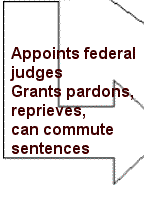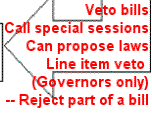
Checks and Balances Flow Chart
Answers:
1. Declare laws unconstitutional.

In this action, the judicial branch is controlling both of the other two branches.
This power is known as judicial review. It is not found in the Constitution but was established by the Supreme Court under Chief Justice John Marshall. The precedent-setting case, Marbury vs. Madison, came in 1803, when Madison refused to seat one of John Adams' "midnight justices." Marshall elevated the Supreme Court to a co-equal branch with the executive and the legislative branches by asserting that the Court had the power to nullify laws passed by Congress and actions taken by the president.
2. Grant pardons, reprieves, and commute sentences.

In these actions, the President is acting as a judge, exercising judicial powers. A pardon means that no prosecution can be levied against anyone receiving a pardon. A reprieve is a delay in carrying out a sentence, often the death penalty. A commutation of a sentence consists of reducing its severity, possibly from the death penalty to life imprisonment.
3. Veto bills.

Here the executive has control over the legislative branch. The
veto is one of the president's most potent and basic weapons against the
Congress. He must act within ten days of receiving the bill from Congress. If he
fails to act within that time and if Congress is in session, the bill becomes
law.
If Congress has adjourned and the bill has not been signed after ten days, the
bill dies and president does not need to act on it further. This action is known
as a "pocket veto," as if the president placed it in his pocket and
forgot about it. A formal veto involves the president returning the rejected
bill to Congress with recommendations on why it was rejected and what Congress
can do to remediate the issues involved in its failure.
4. Confirms presidential appointments

According to Article 2, Section 2, Clause 2 of the US Constitution, the US Senate must give its "advice and consent" to presidential appointments for both the federal judiciary and offices within the executive branch. The Senate will hold hearings in committee and vote on the nomination. If a majority of the appropriate committee agree, the nomination is "reported favorably to the floor" of the whole Senate, where further debate can ensue. A simple majority is needed to confirm a presidential appointment. If there is a tie, the vice president will cast the tie-breaking vote as President of the Senate.
5. Has control of the US budget.

The US House of Representatives was given the power to begin all bills dealing with money and taxation, and the Senate must agree since all bills require approval of both houses of Congress. The powerful ways and means and appropriations committees in the House determine which tax bills will make it to the floor. Since House members are elected every two years, they must pay special attention to the wishes of the American people, who have traditionally suspicious of heavy taxation, a sentiment that reaches to the time of the Founding Fathers. It was that special group that awarded the house the "power of the purse" as an incentive for the large states to agree to the Great Compromise of the Constitutional convention.
6. Federal judges are appointed for life.

Once on the federal bench, judges on the US District Court or US Court of Appeals, as well as justices on the US Supreme Court, are in their positions for life as long as they act with "good behavior." Judges and justices can be impeached and removed by Congress, but barring such action, their lifetime tenure allows them to act free of political considerations or loyalty to the president that appointed them. The fact that a justice can serve on the Supreme Court can give one person influence of the direction of the court for up to half a century. Presidents John Kennedy and Gerald Ford both made appointments to the high court that lasted much longer than the two-to-three year presidential terms. Kennedy appointed Byron White, who served from 1962 to 1993. Ford appointed John Paul Stevens, who is still on the court as the oldest and longest serving Supreme Court justice.
7. Impeachment of federal officials, including the President
Impeachment is one of the most misunderstood forms of the checks
and balances system, but it is a critical check on executive power by the
legislature in the Constitution. The act of impeachment involves a formal
accusation on the part of the House of Representatives of wrongdoing by the
President or other member of the Executive Branch. Federal judges can also be
impeached. Once indicted by the impeachment vote in the House, a vote that
approves articles of impeachment drawn up by the House Judiciary Committee, the
articles are hand-carried to the senate, where a trial is held. A two-thirds
majority of the Senate is needed to convict the president of what the
Constitution calls "high crimes and misdemeanors."
Two presidents have been impeached: Andrew Johnson, for violating the Office of
Tenure Act, and Bill Clinton, for perjury and obstruction of justice during a
lawsuit dealing with sexual harassment.
8. Override presidential veto

Congress can pass laws over the President's veto, but to do it, they
"really gotta wanna." it takes a vote of two thirds of both houses of
Congress to override a president veto. Andrew Johnson is the most overridden
president with 15 overrides over 21 vetoes in a four year term. (Source: Congressional
Research Service)
9. Can call special sessions of Congress.

When the President calls a special session of Congress, he is asserting executive power over the legislature. Congress does not have to act in response to any of the President's suggestions, but he has a major influence over the Congress as the nation's "chief legislator." The President will most likely call such a session, where both houses meet in a "joint session," in a time of national crisis, such as when president Bush addressed Congress and the nation after the terrorist attacks of September 11, 2001.

The President addresses a joint session of Congress.
Courtesy: http://www.whitehouse.gov
10. Can establish courts, set number of judges.

Congress has the power to influence the size and structure of
the Judiciary by powers given to it by the Constitution. Article III states:
The judicial power of the United States, shall be vested in one Supreme Court, and in such inferior courts as the Congress may from time to time ordain and establish.
Franklin Roosevelt hoped to expand the number of Supreme Court justices to fifteen in order to save his new Deal legislative program from being declared unconstitutional, but the "court packing scheme," as it came to called failed, as Congress refused to expand the size of the court from its number of nine, which it has been since 1869.
Back to interactive Checks and Balances Flow Chart
Back to Lesson on Checks and Balances
George Cassutto's Cyberlearning World
[Lesson Plan of the Day] [Cassutto Memorial] [About the Author] [Search] [Civics Lesson Plans]